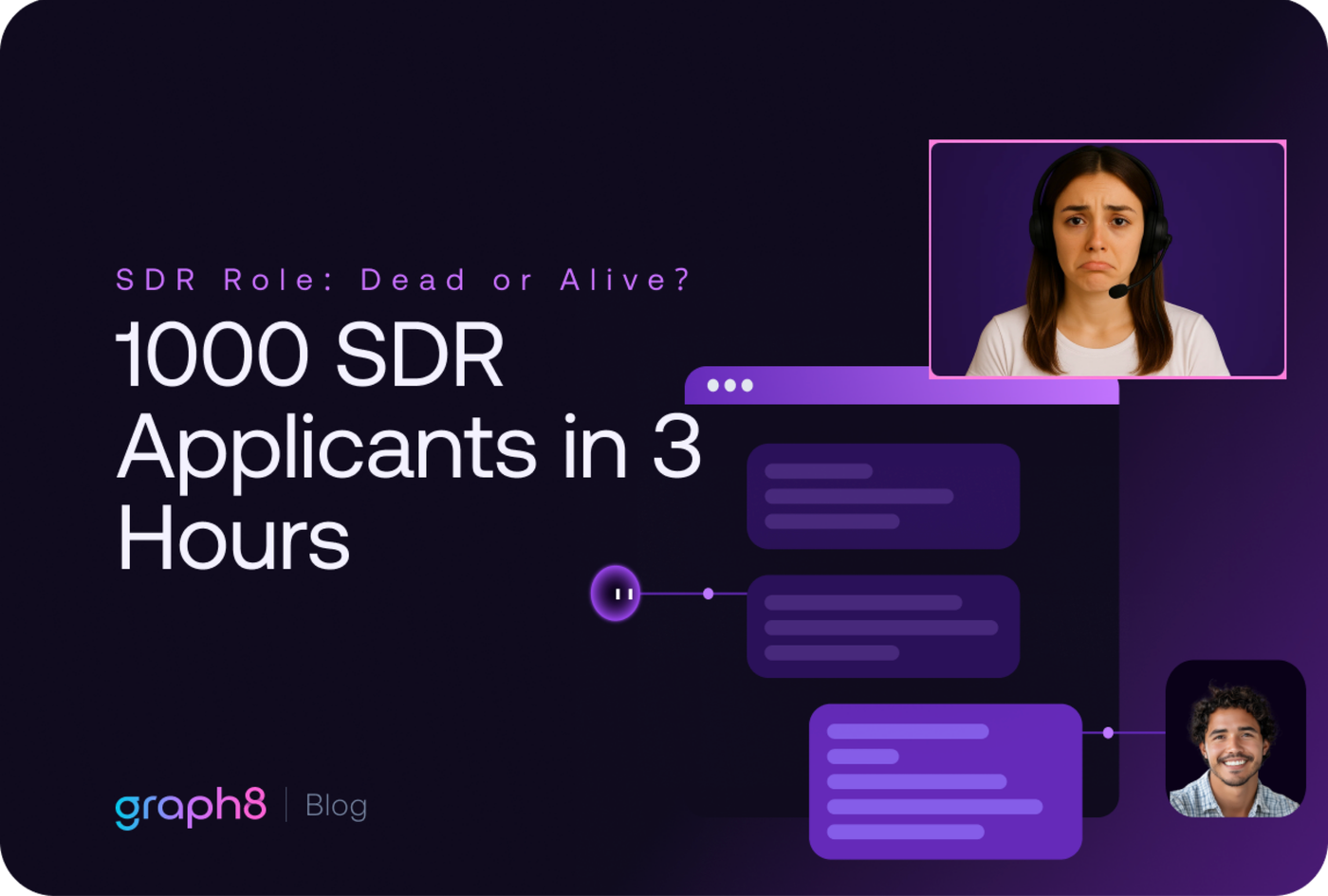April 24, 2025: we hit "Publish" on our SDR job posting—and within hours, over 1,000 SDR candidates from across the U.S. flooded our careers page.
In two years, what once drew 25 to 50 résumés in a day turned into an all-out application frenzy. Was this just graph8’s AI-forward employer brand at work, or is something bigger happening in sales development?
Is the SDR role a dying breed—or on the cusp of its greatest reinvention? We decided to dig deeper, starting with the forces reshaping SDR careers and ending with where headcount will settle in the next three years.
Four Converging Forces Driving the SDR Application Tsunami
Gen Z’s Unprecedented Job Mobility
- Quantitative Data: According to a 2024 Bankrate report, 39 % of Gen Z workers plan to leave their current job within the next year (newsweek.com). Additionally, 48 % of all U.S. workers say they will either quit or relocate for work in the coming year (bankrate.com).
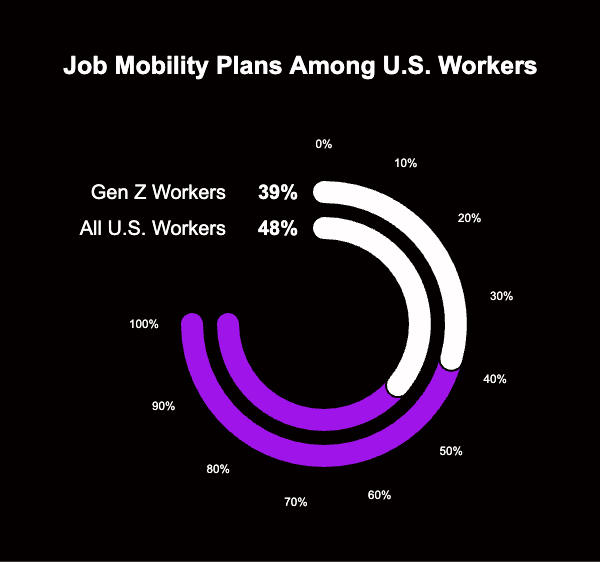
- Why It Matters: Gen Z, now numbering over 60 million in the U.S., entered the workforce amid economic upheaval. They prioritize rapid skill acquisition, purpose-driven work, and transparent career ladders—all qualities embodied by modern SDR roles at innovative companies like Graph8.
- Anecdote: When I visited a local university career fair several years earlier aa part of Cience (leading SDR Outsourcing Agency), nearly 20% the students I spoke with had an SDR role (or equivalent) on their “career radar.” They viewed it as a foot in the door to enterprise technology careers.
Remote Work Has Flattened Geography
- Quantitative Data: As of August 2024, 22.8 % of U.S. employees teleworked at least part-time—up from 19.5 % in 2023—and hybrid schedules added another 11.7 %, meaning 36 million Americans work remotely at least some days .
- Impact: Remote-friendly SDR roles attract candidates from rural markets who previously had limited access to B2B tech employers, exponentially widening applicant pools.
- Anecdote: One of our top candidates hailed from Des Moines, Iowa—something unimaginable before remote-first dynamics.
Automation Transformed SDR Work From Repetitive to Strategic
- Quantitative Data: McKinsey projects automation could displace 400–800 million jobs by 2030 globally, yet roles centered on human connection—like SDR—are reframed, not eradicated .
- Efficiency Uplift: Exceed AI’s analysis shows automation can reclaim 4 extra selling hours per SDR per week and boost productivity by 35 %, allowing organizations to maintain or increase output with up to 26 % fewer SDRs .
- Role Evolution: Today’s SDR spends more time analyzing intent data, orchestrating multi-channel cadences, and crafting personalized insights for prospects—activities that require creativity, emotional intelligence, and technical fluency.
graph8’s Innovation Magnetizes Top Talent
- Quantitative Data: According to an Aptitude Research study, 66 % of candidates perceive AI-driven recruitment and workplace technologies positively, with 70 % expecting employers to leverage AI for everyday tasks by end of 2025 .
- Employer Brand Impact: By publicly sharing our AI-driven SDR playbook—complete with video demos of our voice-AI assistant and dashboards —we positioned graph8 as a pioneer, drawing applications from individuals eager to both learn and contribute to next-gen sales ops.
The SDR Landscape: Headcount, Growth & Projections
The scale of this surge only makes sense when viewed against the larger SDR workforce.
| Metric | Value Today | Projected 2030 | Source |
|---|---|---|---|
| Total U.S. SDRs | 677,479 | Scenario-dependent | Tenbound (2024) |
| 10-year Growth Rate (2018–2028) | +4 % (~63,300 new roles) | +4 % → ~740,800 SDRs | Zippia (2023) |
| Total U.S. AEs | 1.15 million | +5 % → ~1.21 million AEs | LinkedIn/Industry reports |
| Remote Work Prevalence | 22.8 % | 30 %+ telework by 2030 | BLS (2024) |
| AI Productivity Uplift for SDRs | +35 % selling time | Up to +50 % with next-gen automations | Exceed AI (2024) |
Even under a steady 4 % growth path, headcount barely surpasses 740 K by 2028. Yet Graph8’s single posting—1.5 × that decade’s net job creation—underscores that larger macro trends around work and technology, not just raw role openings, are driving this rush. In fact, with SDR positions under pressure and many teams shrinking under “do more with less” mandates, this surge may reflect not only enthusiasm but also a sense of desperation: candidates know opportunities are contracting and are racing to secure their spot before headcount cuts bite deeper.
Deep Dive: Why Do SDR Applications Keep Skyrocketing?
The ‘Great Reorientation’ of Career Priorities
Workers across generations are no longer satisfied with static roles. According to Gartner’s 2024 Future of Work survey, 54 % of employees say “meaningful work” and “opportunities to innovate” rank higher than salary when evaluating new positions.
Nationwide Career Fairs—Every Time You Post
In the pre-remote era, hiring was a local affair. Today, every remote-enabled JD transforms into a nationwide—and sometimes global—career fair. Internal data from Indeed shows remote job listings get 4.5× more applications than on-site roles, even when compensation ranges are identical.
Automation Shrinks Headcount, Elevates Impact
- Lean but Lethal Teams: If automation yields a 35 % productivity bump, teams can achieve prior pipeline goals with 26 % fewer heads—a boon for CFOs and a call to arms for SDRs to upskill in creative and analytical domains.
- New Skill Bar: SDRs now interpret intent signals, adjust AI-suggested messaging, and serve as liaisons between personalized tech and human empathy—skills that digital natives relish learning.
Employer Brand & Tech Stack as Talent Magnets
Our public-facing blog, webinar series, and open GitHub repos showcasing our platform function as a magnet rather than a filter—Signaling to candidates that at graph8, they’ll not only use but also help build the tools that define modern revenue teams.
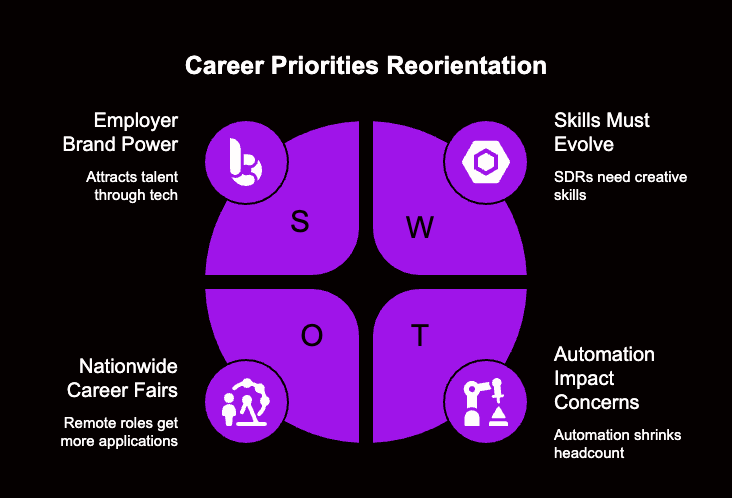
Are SDRs a “Dying Breed”?
Layoffs, Automation & Workforce Evolution
Recent headlines have spotlighted layoffs at Salesforce, Microsoft, and other tech giants—often impacting sales development teams flagged as “non-core” amid AI investments and budget tightening. Yet zooming out, we see not extinction but transformation:
- Layoffs Are Real—but SDR Functions Endure
- A January 2025 survey revealed 45 % of U.S. managers anticipate layoffs this year, affecting both SDR and broader sales support roles.
- BridgeGroup data shows normal SDR attrition runs 25–35 % annually; today’s mix of layoffs plus voluntary departures pushes turnover toward 50 %+, leaving openings for ambitious, upskilled reps.
- Automation Enables ‘Do More with Less,’ Not ‘Do Away with All’
- Productivity gains of 35 % mean organizations can reallocate budget from headcount to training, coaching, and advanced toolsets—reinforcing the value of remaining SDRs.
- Future Headcount Scenarios (2030)
| Scenario | 2025 Headcount | 2030 Headcount | Key Driver |
|---|---|---|---|
| Modest Growth | 677,479 | ~740,000 | Continued 4 % annual growth |
| Tech-Enabled Contraction | 677,479 | ~~500,000 | 35 % productivity gains → 26 % fewer reps |
| Automation-Driven Lean Operations | 677,479 | ~~340,000 | Full automation of routine tasks → 50 % fewer SDRs |
Even in the steepest contraction model, 340,000 AI-augmented SDRs remain—leaner teams focused on high-value, strategic engagement.
Bold Headcount Forecast: From 650K to 250K by 2028
Forget modest growth or mild contraction—here’s my prediction for the next three years:
- 2025 SDR Headcount: ~650,000
- 2028 SDR Headcount: ~250,000
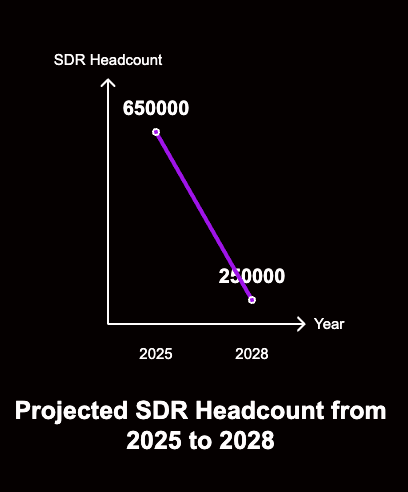
Why the plunge? Automation-driven productivity gains mean organizations can cover sales pipelines with roughly 2.5× fewer reps. Routine qualification, initial outreach, and meeting scheduling will be almost entirely handled by AI—leaving a lean, elite corps of strategic SDRs to engage high-intent prospects.
With fewer than 40 % of today’s SDR roles remaining, success will hinge on AI fluency and consultative skills.
Actionable Recommendations for SDRs & Sales Leaders
For SDRs
- Master AI-Tool Orchestration: Get certified on major platforms (Salesforce Einstein, Outreach AI, Gong Analytics) or better start using graph8.
- Develop Data Storytelling Skills: Translate numbers into narratives—show how your sequences moved pipeline metrics.
- Build a Personal Brand: Publish case studies on LinkedIn about how you used AI to improve open rates or meeting conversions.
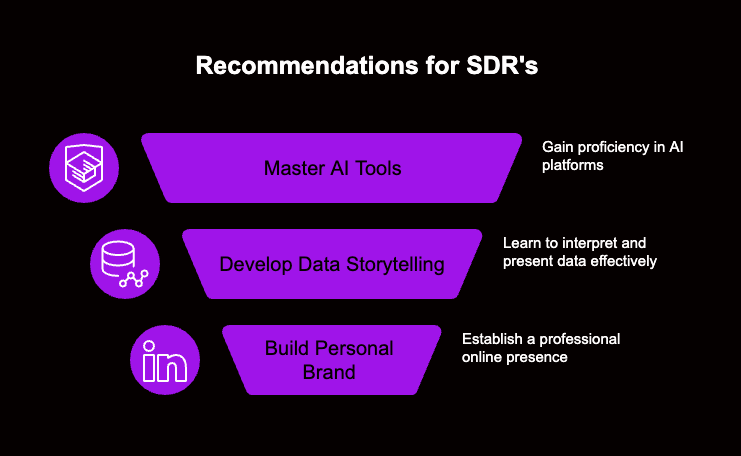
For AEs & Sales Managers
- Redesign Team Structures: Mix AI agents with human SDRs—allocate 40 % of budget to toolsets and training, 60 % to human capital.
- Map Career Paths: Create transparent ladders from SDR → Senior SDR → AE/RevOps/Customer Success, with milestones tied to AI proficiency.
- Invest in Coaching: Provide regular workshops on data analysis, persona-based messaging, and AI-augmentation best practices.
Yesterday taught me more than I ever expected: the SDR role has been reborn. Looking ahead, I predict headcount will shrink from around 650,000 today to just 250,000 in three years—so only the most proactive, AI-savvy candidates will get noticed.
At graph8, many of our 1,000+ applicants didn’t just press “Apply.” They surfaced their skills with data-driven videos, personalized AI-crafted cover letters, and real-time demos of their problem-solving prowess. They approached the job hunt with an AI-first mindset and a hunger to learn—exactly the kind of strategic reps who will thrive in a leaner landscape.
For sales leaders and practitioners, the mandate is clear: build leaner, smarter teams of AI-enabled SDRs or risk being outpaced by competitors who do. If you’re ready to spot and develop the next generation of top-performing reps, let’s start the conversation.
Discover how graph8’s SDR Augmentation Suite can transform your revenue pipeline at https://www.graph8.com

